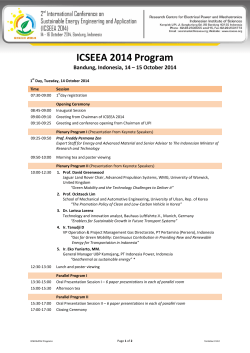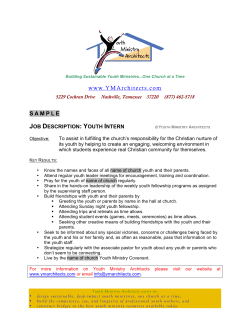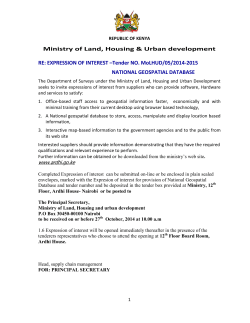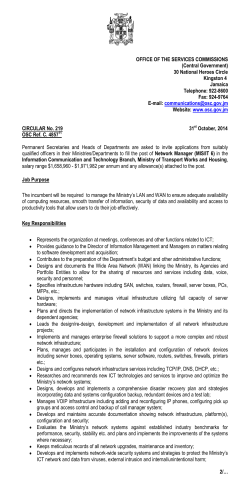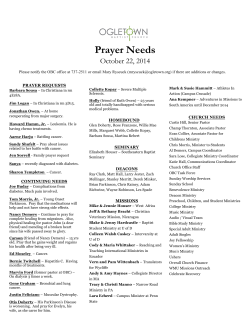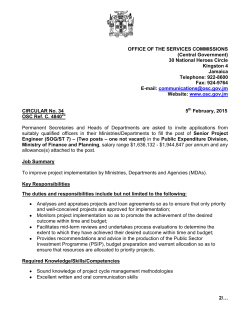
Update of Indonesia`s GHG Abatement Cost Cuve
Contents Update of Indonesia’s GHG Abatement Cost Cuve: LULUCF and Peat Farhan Helmy International Workshop on Forest Carbon Emission Jakarta, 3-5 March 2015 | Outline Background and Context Update on LULUCF and peat emissions 2030 GHG emission outlook Emission abatement opportunities 1 GHG Abatement Cost Curve was build in the context of the need of a fact based assessment to encourage low emission development scenarios Fact-based assessment and exercises at national and sub-national level • Indonesia Climate Change Sectoral Roadmap (ICCSR, Bappenas, 2009) • Green Paper: Economic and Fiscal Policy Strategies for Climate Change Mitigation in Indonesia, Ministry of Finance (2009) • Indonesia’s GHG Abatement Cost Curve (DNPI, 2010) • Low Carbon Growth Strategy (LCGS) at Provincial Level (DNPI, 2010) • Low Carbon Development Options (DNPI, MoF and the World Bank, 2010) • Urban LEDS (ICLEI, UNDP) National Policy Framework and Achievements • National and Regional Action Plans (RAN/RAD GRK) • National GHG Inventory System (SIGN) • Climate Financing and Investment: Indonesia Climate Change Trust Fund (ICCTF), 2009; Fiscal instrument to support GHG Emission Reduction implementation at national/sub-national level, 2012; ther climate financing and investment (JCM, PMR, underway) –2 Technical team: Farhan Helmy (ICCC), Titi Panjaitan, Dicky Edwin Hindarto, Widiatmini Sih Winanti, Muhammad Farid, Doddy S. Sukadri, Dewi Aprianti, Jannata Giwangkara, Emod Tri Utomo (DNPI), Jun Ichihara, Bramantyo Dewantoputra, Astri Indirawati (JICA). For information and input on the LULUCF and peatland sectors: Yetti Rusli, Ruandha Agung Sugardiman, Haryo P (MOF), Rhesa Darojat (MOE), Nirartha Samadhi, Adi Pradana, Listya Kusumawati, Dieni Ulya (UKP4), Umiyatun Hayati Triastuti, Budhi Setiawan (Bappenas), Mukti Sardjono, Mazwar (MOA), Budi Situmorang, Putri Nurul P (PU), Erna Sri A (LAPAN), Surahman, Iin Herawati (BPN), Arif R (ICRAF), Henky Satrio (AMAN), Hultera (WWF), Marissa Malahayati (CCROM SEAP IPB), Eddy S (APHI), Eka Melisa (SKPPI), Farhan Helmy, Dadang Hilman (ICCC), Agus Purnomo, Muhammad Farid, Ari Mochammad, Doddy S. Sukadri (DNPI). For information and input on the power sector: Arie Pujiwati, Aries Z, Gita Lestari, Hermawan, Hery Nursito, Junifer S, Ilham Rakhman, Tedi Yunanto, Yogi Alwenda (ESDM), Paul Butarbutar (MOF), Ridwan Djamaluddin, Laode M. Abdul Wahid, Ira Fitriana, Wahyu Purwanta (BPPT), Diana Rosdiana (DEN), Amna A, Ishak Burhani, Kamia Handayani (PLN), Asclepias Rachmi, Azis Pusakantara (IIEE), Jon Respati, D.A. Purbasari (Surya University), Fabby Tumiwa (IESR), Surya Darma, Ananda Setiyo Ivannanto, Andhika Prastawa (METI), Verenia Andria (UNDP), Takeshi Enoki (MUFG), Rob Daniel, Tim Boothman (PWC), Leela Raina (Strategic Asia), Artissa Panjaitan (ICCC), Widiatmini Sih Winanti, Moekti Soejachmoen, Dicky Edwin Hindarto (DNPI), Arief Sugiyanto (PLN). For information and input on the road transport sector:Tonny AS, Fahni Mauludi, Mohammad Malawat (MOT), Budi Prasetyo Susilo, Freddy A. Sutrisno (GAIKINDO), Yusa Cahya (MTI), Agus Salim Suseno (PT Honda Prospect Motor). 3 Emission Projection 2010 www.iccc-network.net 4 Emission Reduction Potentials 2010 www.iccc-network.net 5 UPDATE ON BUSINESS-AS-USUAL FIGURES Much new research and reports have been published since the GHG Cost Curve report was released in 2009 The Government of Indonesia issued several reports related to climate change… …while national and international publications have been advancing the methodology for carbon calculations SOURCE: Ministry of Forestry; Ministry of Environment; BAPPENAS; UKP4; DNPI; Journals and publications; Team analysis –6 LULUCF and Peat remain the largest source of emission in the next decade Indonesian emissions are estimated to grow from 1.6 to 2.6 GtCO2e between 2010 and 2030 Projected emissions1, Million tons CO2e 2,609 75 108 151 232 +68% 1,846 1,577 26 136 105 25 45 143 104 145 31 1,011 38 Buildings Cement Petroleum and gas Indonesia has the potential to up to 1.2 Gt per year by 2030 Agriculture Societal perspective1, 2030 Transport Reduction cost2 Power USD per tCO e reduce CO2 emissions by 2 72 389 227 Solar PV Biomass dedicated Grassland management 100 Small hydro 0 986 990 995 0 LULUCF & Peat2 100 200 300 400 500 600 700 800 900 1,000 -100 -150 2010 2020 2030 -200 3% 4% -250 Share of global emissions3 1 Includes only direct emissions from each sector 2 Emissions from LULUCF are based on a net emission approach i.e., including absorption 3 Based on 2011 estimates showing global emissions at 51.7 Gt and 67.6 Gt in 2010 and 2030, respectively -450 Peat management Improve community practices Afforestation/ reforestation -350 -400 1,200 1,300 Nuclear Clinker substitution Sustainable by Slag logging practice -300 SOURCE: Indonesia GHG Abatement Cost Curve 1,100 Large hydro Degraded land restoration Co-generation - downstream Geothermal Fire prevention on mineral soils Spatial planning Appliances - refrigerators, commercial Passenger Vehicle gasoline Bundle 4 Two Wheeler Electric 1 Societal perspective implies utilizing a 4% discount rate 2. The width of each bar represents the volume of potential reduction. The height of each bar represents the cost to capture each reduction initiative SOURCE: Indonesia GHG Abatement Cost Curve SOURCE: Ministry of Forestry; Ministry of Environment; BAPPENAS; UKP4; DNPI; Journals and publications; Team analysis –7 UPDATE ON LULUCF AND PEAT EMISSIONS – CARBON STOCK ABOVE GROUND Indonesia’s deforestation shows a declining trend since 1996 Annual deforestation rate, 1992 - 20131 In million hectares 4.1 2.2 1.0 0.8 0.4 Between 1992-96 Between 1996-2000 Between 2000-03 Between 2003-06 Between 2006-09 0.6 Between 2009-13 1 Only spatial map in 1992, 1996, 2000, 2003, 2006, 2009, and 2013 available; the deforestation rate is assumed constant in between the two data points available SOURCE: Ministry of Forestry land cover maps; Team analysis 8 UPDATE ON LULUCF AND PEAT EMISSIONS – CARBON STOCK ABOVE GROUND Indonesia’s deforestation shows a declining trend has since 1996 Deforested area 1992 – 1996 deforest ation 1992 – 2000 deforest ation 1992 – 2003 deforest ation 1992 – 2006 deforest ation 1992 – 2009 deforest ation 1992 – 2013 deforest ation SOURCE: Ministry of Forestry land cover maps; Team analysis Forest area 9 UPDATE ON LULUCF AND PEAT EMISSIONS – CARBON STOCK ABOVE GROUND Land cover change analysis shows that more than 50% of deforestation is results in degraded land Forest cover change to other land cover, 2000-09 Total area = 6.5 million ha Others 10% Agriculture 15% 13% Estate crops 1% Mining 9% 53% Shrubland SOURCE: Ministry of Forestry; Team analysis Plantation forest 0% 53% of deforested area is converted into shrub, which does not give significant impact to economic development The degraded areas should be made available for green development and community development programs Settlement 10 UPDATE ON LULUCF AND PEAT EMISSIONS – CARBON STOCK ABOVE GROUND We estimate 13 million ha forests are at risk of planned deforestation and forest degradation SOURCE: Ministry of Forestry 2009; WRI 2010; Team analysis 11 UPDATE ON LULUCF AND PEAT EMISSIONS – CARBON STOCK BELOW GROUND ~40% of Indonesia’s peatland area is assigned as APL and HPK, which puts ~6 mn ha under threat of conversion XX Share of total, Percent Peat soil distribution Peat area, million hectares Under threat of degradation Under threat of conversion Under threat of degradation Under threat of conversion 14.9 3.5 2.4 4.2 3.0 1.8 Protected area HPT HP HPK APL 20 12 28 16 23 SOURCE: Ministry of Agriculture peatland map; Ministry of Forestry land use map; Team analysis Total 12 UPDATE ON MORATORIUM – CARBON STOCK ABOVE GROUND The Moratorium puts ~48 mn ha of forests and peatland under protection, of which ~6 mn ha is under serious risk of being converted 1 Assuming moratorium policy is well-implemented and enforced SOURCE: Ministry of Forestry; Team analysis 13 UPDATE ON MORATORIUM – CARBON STOCK BELOW GROUND Current moratorium protects ~4.8 mn ha of peat from being converted into land-use related activities Peat area protected from further conversion In million hectares 7.8 Total area = 4.8 million hectares 3.0 Moratorium 0.9 7.8 1.4 1.7 0.9 Total Protected area HPT 0.0 0.9 HP HPK APL Peat soil 7.1 Outside moratorium 2.8 7.1 0.8 2.6 Total Protected area SOURCE: Ministry of Forestry land use map; Ministry of Agriculture peatland map; Team analysis HPT HP HPK APL 14 Six abatement opportunities should be prioritized (548 MtCO2e by 2030 1 Spatial planning and land use optimization (134 MtCO2e) Classify high-carbon forest and peatland into conservation area, and subsequently release lowcarbon stock area for economic activities 4 Sustainable logging practices (48 MtCO2e) Reduce forest degradation through RIL and enrichment planting practices, and reduce the need for plantation expansion through yield improvement 134 MtCO2e 2 Forest and peat moratorium (91 MtCO2e) Extend forest and peat moratorium to indefinite time to protect HCV areas 3 Peatland management (141 MtCO2e) Slow the emission from degraded peatlands by re-wetting or replanting damaged areas and by establishing a fire management system 5 Improvement in local community practices (76 MtCO2e) Reduce slash&burn by providing land) tenure, livelihood training, education and awareness, and disincentives for forest clearance 6 Afforestation and reforestation (54 MtCO2e ) Conduct reforestation in lessattractive areas for longterm, permanent carbon sink 15 EMISSION ABATEMENT OPPORTUNITIES 548 MtCO2e could be abated in 2030 by implementation of 6 different abatement levers Societal perspective; 2030 Abatement cost USD per tCO2e High estimate Low estimate 50 45 40 Peat management 35 Spatial planning and land use optimization Afforestation /reforestation 30 25 Improve community practices Sustainable logging practice 20 Forest and peat moratorium 15 10 5 0-3 0 3 0 0 20 40 60 10 - 15 5 - 10 0-5 0-5 0-5 5 5 0 5 0 5 0 5 5 10 80 100 120 140 160 180 200 220 240 260 280 300 320 340 360 380 400 420 440 460 480 500 520 540 560 Abatement potential MtCO2e per year Note: The curve presents an estimate of the maximum potential of all technical GHG abatement measures below EUR 60 per tCO2e if each lever was pursued aggressively. It is not a forecast of what role different abatement measures and technologies will play. Assuming a 4% societal discount rate SOURCE: Team analysis THANK YOU! –17
© Copyright 2025
